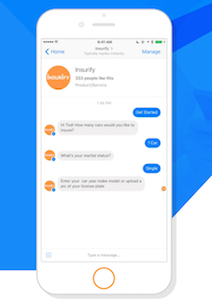 Insurify, makers of a conversational chatbot solution for the car insurance market, recently announced a funding raise of $4.6M led by MassMutual Ventures and Nationwide Ventures. The Insurify bot can be accessed from Facebook Messenger and helps users shop for car insurance by answering a few questions.
Insurify, makers of a conversational chatbot solution for the car insurance market, recently announced a funding raise of $4.6M led by MassMutual Ventures and Nationwide Ventures. The Insurify bot can be accessed from Facebook Messenger and helps users shop for car insurance by answering a few questions.
In a previous post I’d written about the growing trend of natural language powered virtual agent and chatbot solutions to focus on specific verticals. From a technical standpoint, designing a successful customer experience is more manageable when the NL-powered conversational user interface is only expected to understand one well-known domain.
The Insurify business model fits well into this trend of the verticalization of NL-powered customer service solutions. The objective of Insurify’s conversational bot is to provide people shopping for car insurance a quick and painless way to get insurance advice and compare quotes from their smartphones.
The insurance industry is obviously aware of the continuing shift in how consumer’s shop for and purchase big ticket items such as car insurance. The fact that MassMutual Ventures and Nationwide Ventures funded the startup’s latest round shows that the industry as a whole doesn’t want to be left behind. In fact, according to the press release, 15 of the top 20 carriers participate in some way in Insurify’s platform.
The continued success of domain-focused NL-powered conversational agents sheds light on another important development. Intelligent assistants, as we like to call them here at Opus Research, are beginning to expand far beyond their original question-answering self-service roles. Many people still think of enterprise intelligent assistants as simple NL-powered question answering systems. People were thought to use such assistants to quick info about a company’s store hours or return policies, or perhaps get an update on account balances.
Of course enterprise intelligent assistants can do all of those things. But we’re charting new territory every day. Consumers shifted from picking up their landlines to get support, to shopping and seeking support from their desktops, to now doing everything from their smartphones. Some consumers are even starting to make purchases from in-home voice assistants such as Amazon Alexa.
And recent numbers from Strategy Analytics forecast that some 970 million devices with voice-activated functionality will be in use around the world in 2020.
Domain-specific solutions such as Insurify’s show that NL-powered platforms are working hard to keep up with this shift. Today, their efforts are fragmented, and encounters with virtual agents or MetaBots feel haphazard. Ideally, within the next decade, the quality and frequency of successful encounters with intelligent assistants will prompt individuals to initiate the majority of their purchases through conversations with smart virtual agents.
Categories: Conversational Intelligence, Intelligent Assistants, Articles

 Getting It Right: What AI Agents Actually Mean for Customer Support (Webinar)
Getting It Right: What AI Agents Actually Mean for Customer Support (Webinar)  Beyond the Basics: How AI Is Transforming B2B Sales at TP
Beyond the Basics: How AI Is Transforming B2B Sales at TP  Five9 Launches Agentic CX: Toward AI Agents That Reason and Act
Five9 Launches Agentic CX: Toward AI Agents That Reason and Act  2025 Conversational AI Intelliview: Decision-Makers Guide to Self-Service & Enterprise Intelligent Assistants
2025 Conversational AI Intelliview: Decision-Makers Guide to Self-Service & Enterprise Intelligent Assistants